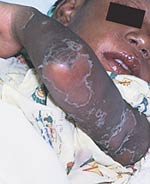Corticosteroid use for Kawasaki disease patients remains controversial
Recently published data from Harvard note a subset of patients may benefit but do not advocate for routine treatment.
MIAMI BEACH, Fla. – The role of corticosteroids to treat patients with Kawasaki disease is controversial.
In some patients who are refractory to standard treatment, corticosteroids have proven useful; however, for primary treatment, steroids have had virtually no role. A recent report in The New England Journal of Medicine noted that there may be a small subset of patients who show a slight benefit from steroids in the acute phase; however, the Harvard researchers did not advocate the addition of a single pulsed dose of IV methylprednisolone to conventional intravenous immune globulin therapy for routineprimary treatment.
Jane W. Newburger, MD, and colleagues conducted a multicenter, randomized, double blind, placebo-controlled trial to assess if adding IV methylprednsonone to conventional primary therapy made a difference in the rate of coronary-artery abnormalities.
Researchers randomly assigned Kawasaki patients with 10 or fewer days of fever to receive IV methylprednisolone, 30 mg per kilogram of body weight (101 patients), or placebo (98 patients).
“All patients then received conventional therapy with IV immunoglobulin, 2 g per kilogram, as well as aspirin, 80 mg to 100 mg per kilogram per day until they were afebrile for 48 hours and 3 mg to 5 mg per kilogram per day thereafter,” the researchers wrote.
The researchers noted that patients in both study groups had similar coronary dimensions at weeks one and five. However, “as compared with patients receiving placebo, patients receiving IV methylprednisolone had a somewhat shorter initial period of hospitalization (P=.05) and, at week one, a lower erythrocyte sedimentation rate (P=.02) and a tendency toward a lower C-reactive protein (CRP) level (P=.07),” the researchers wrote. The two groups also had similar numbers of days spent in the hospital and similar rates of adverse events.
Speaking at Miami Children’s Hospital 42nd Annual Pediatric Postgraduate Course, “Perspectives in Pediatrics,” Infectious Diseases in Children Editorial Board member Stanford T. Shulman, MD, said the research raises some interesting questions, but it will take more studies to prove whether a defined subset of patients may actually benefit from this therapy.
Shulman, a professor of pediatrics at the Northwestern University Feinberg School of Medicine and chief of the division of infectious diseases at The Children’s Memorial Hospital in Chicago, discussed diagnostic criteria and treatment options for Kawasaki disease (KD) at the meeting.
Typically, KD can be diagnosed in patients who have a fever for at least five days and at least four of the five following symptoms: bilateral conjunctival injection; cervical adenitis; a rash that is truncal, polymorphous but non-vesicular; inflamed oral mucosae or inflammation in the hands and feet, Shulman said. KD can also be considered as a diagnosis in patients where there is no alternate diagnosis, or in patients who have prolonged fever in addition to three out of the five aforementioned criteria paired with coronary abnormalities.
The epidemiology of KD is mostly in 18- to 24-month-olds, with 80% younger than 5 years. Boys are more commonly infected; the incidence has been about three boys to two girls, and there is a strong Asian predominance. However, Shulman said, the incidence rate in whites and blacks surges close to that of the Asian population during epidemics.

There are no proven environmental triggers to this illness.
Shulman said one of the important changes in understanding this disease is the recognition of those patients who present atypically.
The American Heart Association has developed an algorithm to help physicians deal with those patients who present atypically, specifically for patients who present with five days of fever and only two or three of the classic diagnostic criteria.
The algorithm advocates assessing the individual characteristics. If the patient’s characteristics are consistent with KD, the AHA advocates assessing the laboratory profile, looking for inflammatory markers. If the CRP and erythrocyte sedimentation rate (ESR) markers are normal or only slightly elevated, the patient can be followed daily, and if the fever resolves and there is no peeling of the fingers, the patient probably does not have KD. If they develop peeling of the fingers, the AHA advocates performing an echocardiogram.
If the CRP is greater than 3.0 mg/dL and/or the ESR is greater than 40 mm/hr, the AHA recommends treatment if the patient has three or more of the supplemental laboratory criteria. If the patient does not have three of the supplemental laboratory criteria, the AHA recommends an echocardiogram.
Shulman said that treatment of KD should ideally start within 10 days of illness onset. In the acute phase, treatment should include IVGG 2 mg/kg plus aspirin 80 mg to 100 mg/kg per day until the 14th day of illness. During the convalescent phase, treatment should include aspirin 3 mg to 5 mg/kg a day for six to eight weeks. For patients with coronary abnormalities, Shulman advocates prolonged ASA or clopidogrel with coumadin for severe coronary abnormalities.
Long-term effects
Shulman noted certain prognostic factors for long-term cardiac complications, including presenting with KD at an early age – younger than age 1 – or a prolonged or recurrent fever. Also, patients with thrombocytopenia, anemia and/or hypoalbuminemia are all at risk for long-term cardiac problems.
Fifty percent of children who develop coronary abnormalities have resolution of abnormalities in their first two years. There is also a slowly increasing rate of children with coronary stenosis – up to about 20% at 17 years of follow-up in one study, Shulman said.
Shulman also said there is increased recognition of adults with ischemic heart disease who had suspected KD early in childhood, which may have left them with permanent coronary artery damage. – by Colleen Zacharyczuk
For more information:
- Shulman ST. Kawasaki Disease 2007. Presented at: The Miami Children’s Hospital 42nd Annual Pediatric Postgraduate Course, “Perspectives in Pediatrics.” March 19-22, 2007. Miami Beach, Fla.
